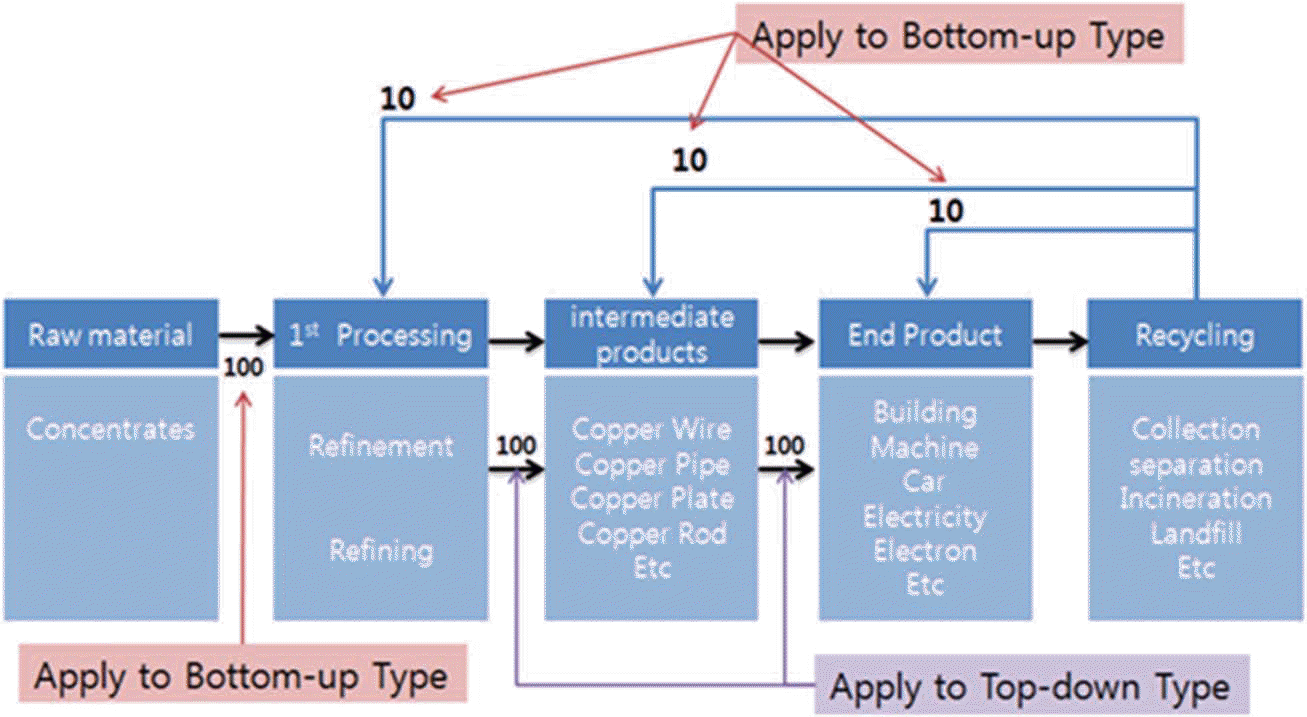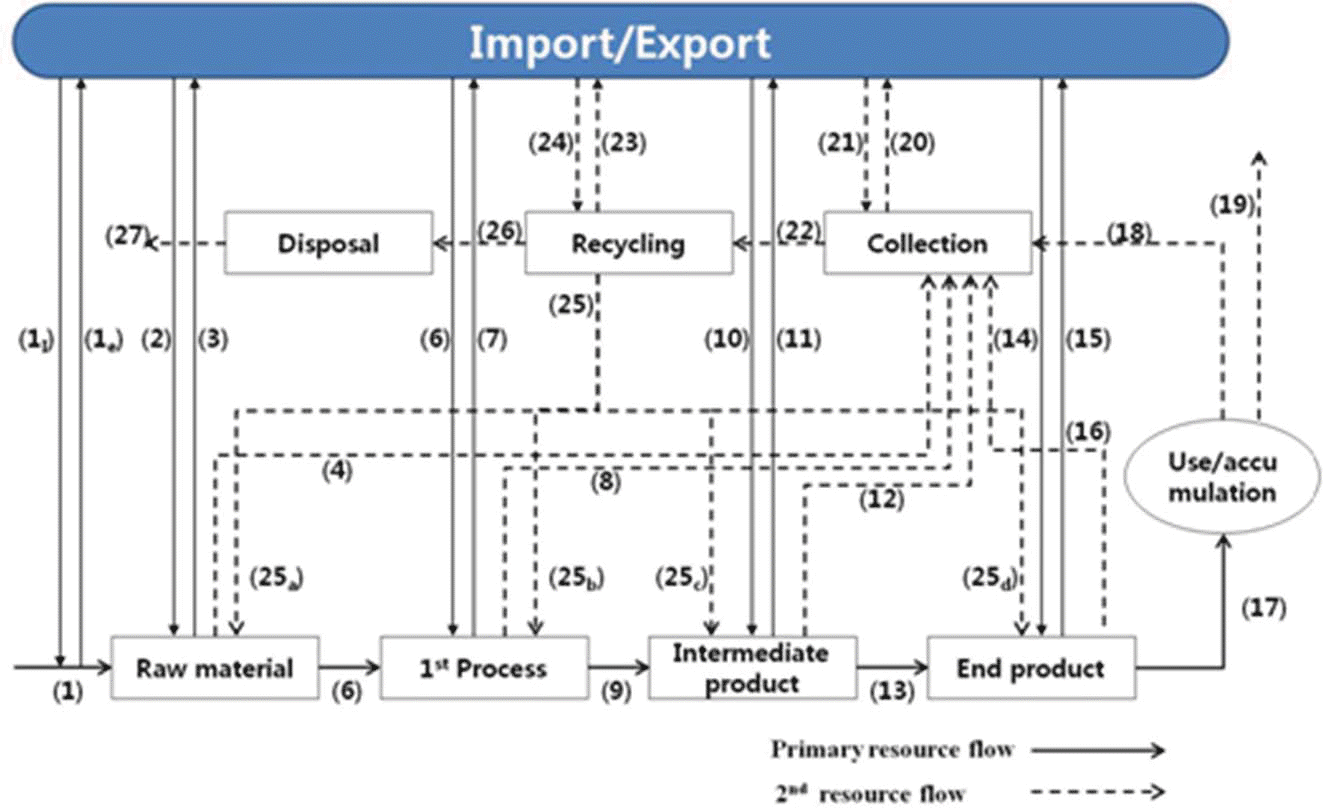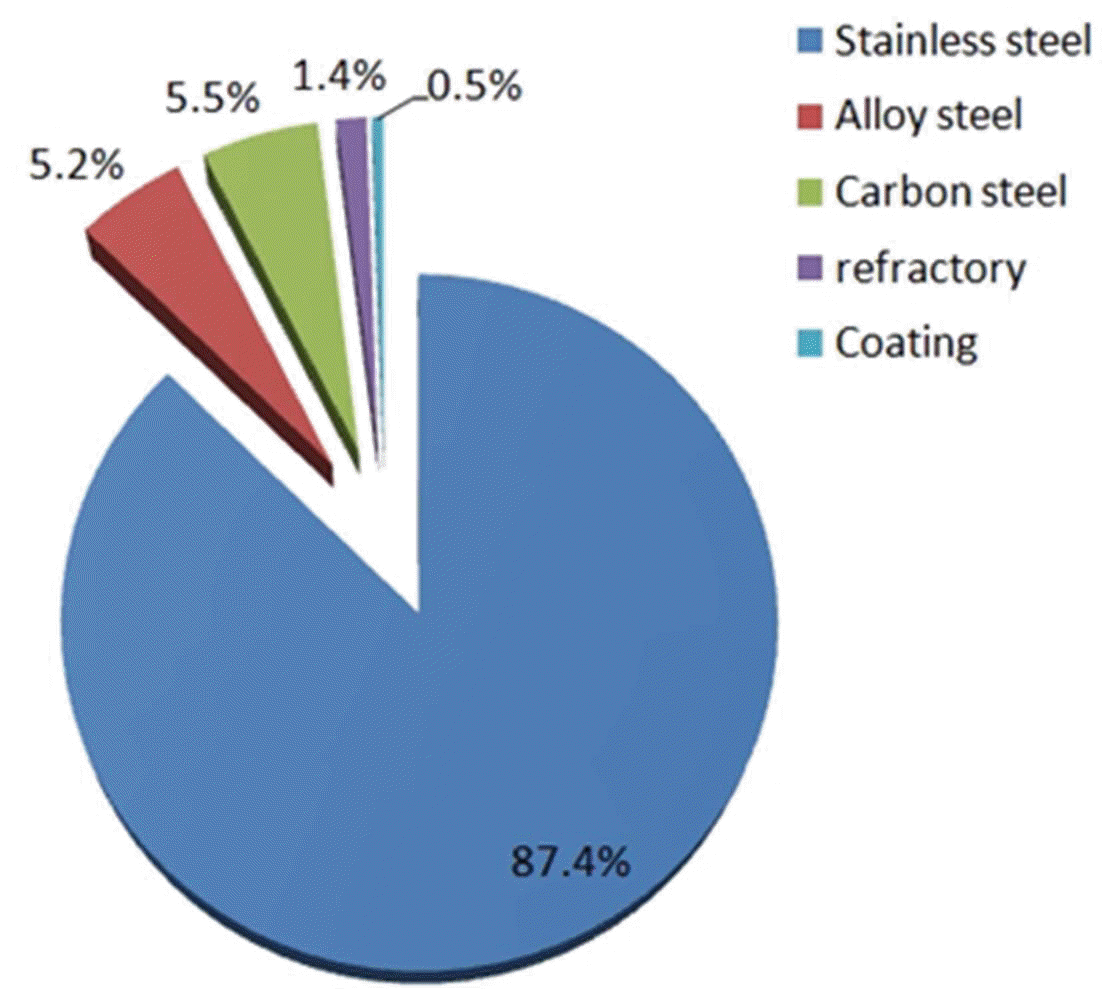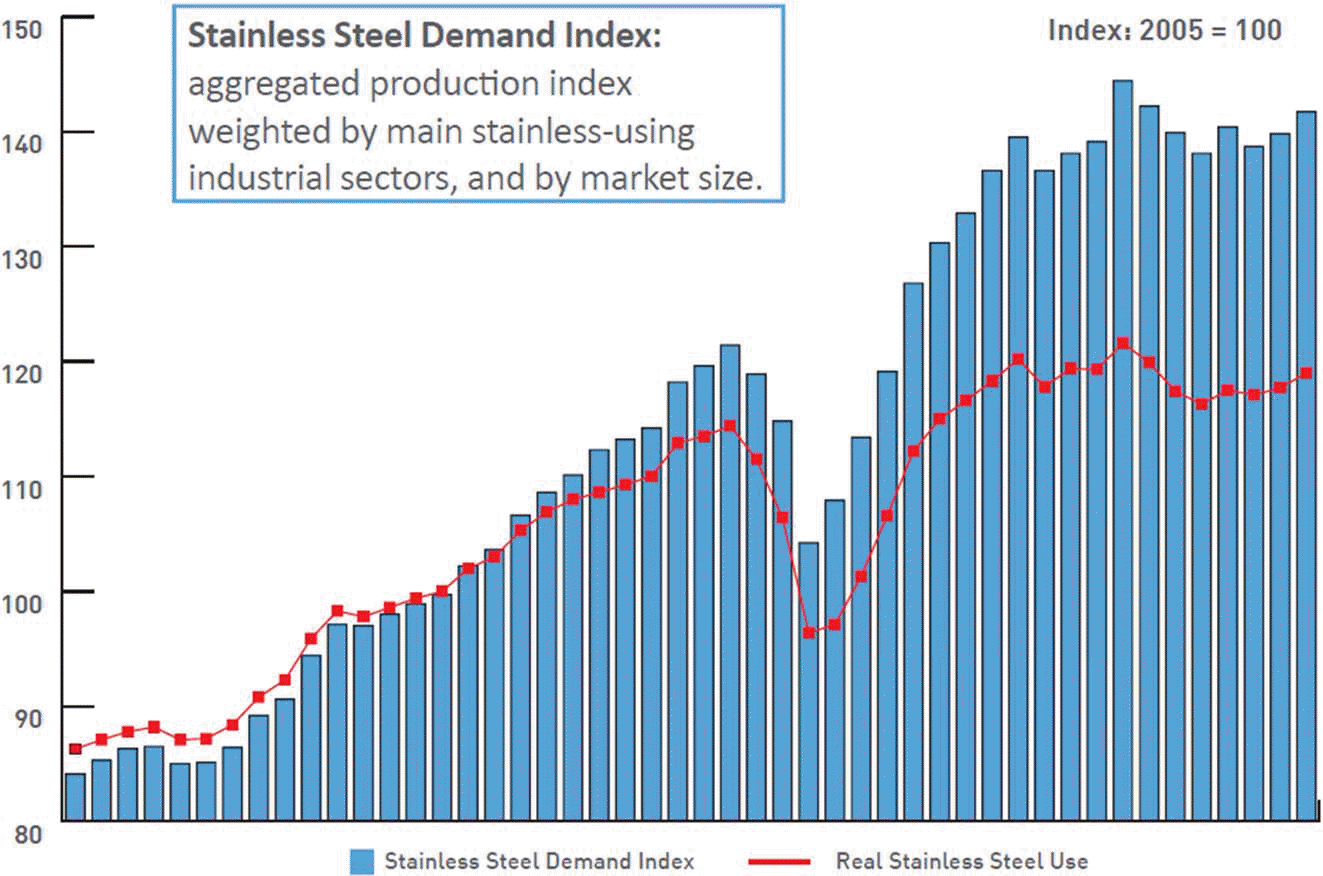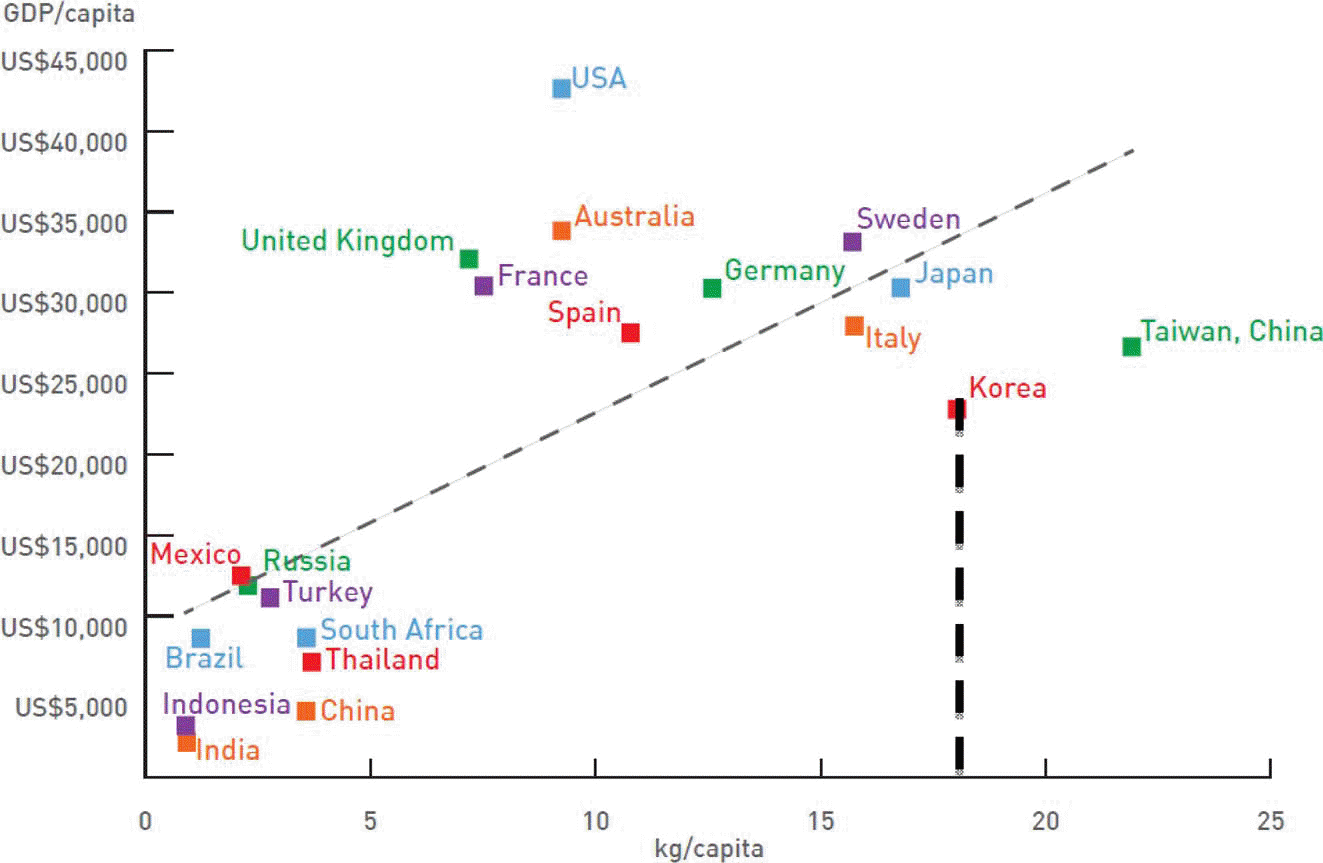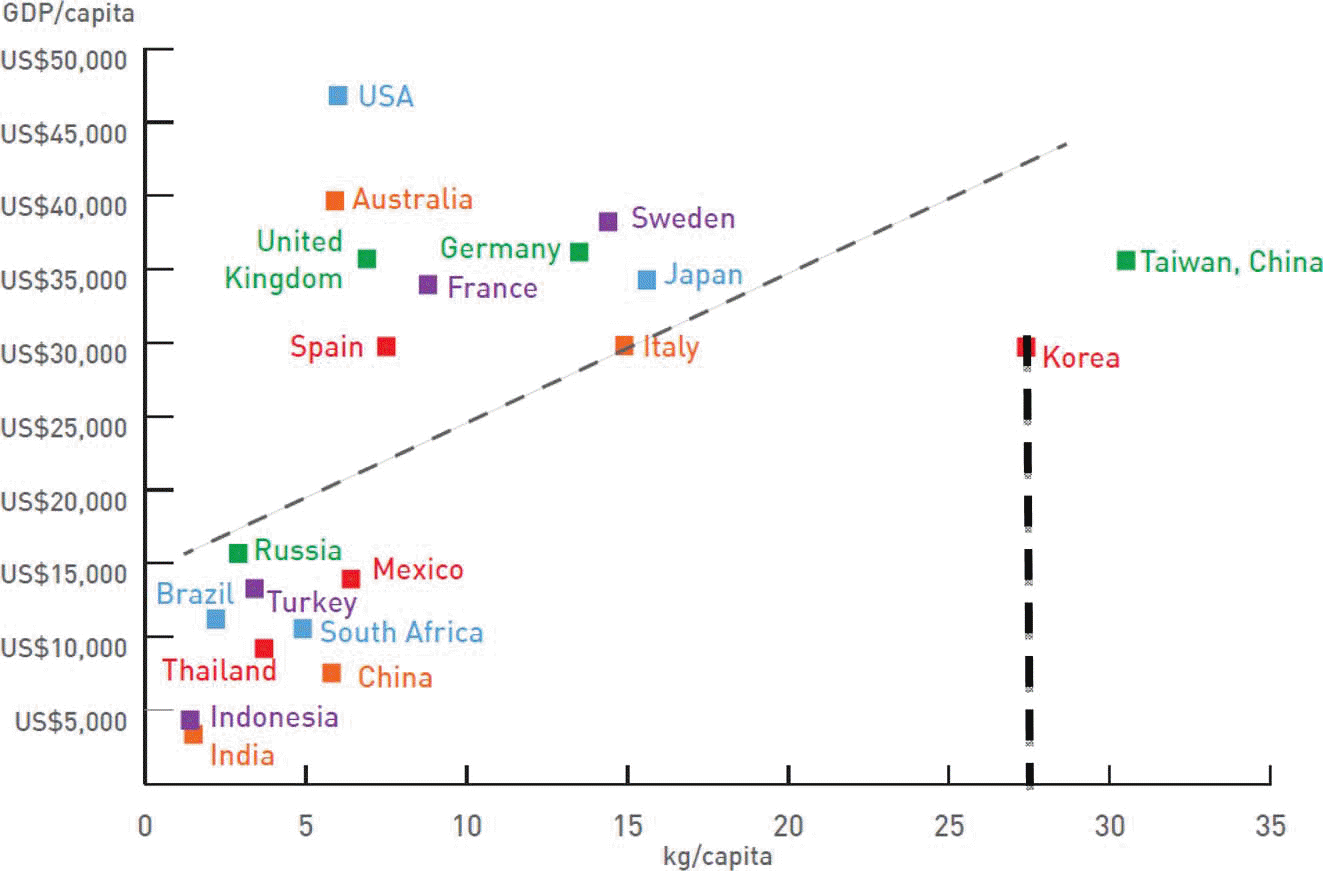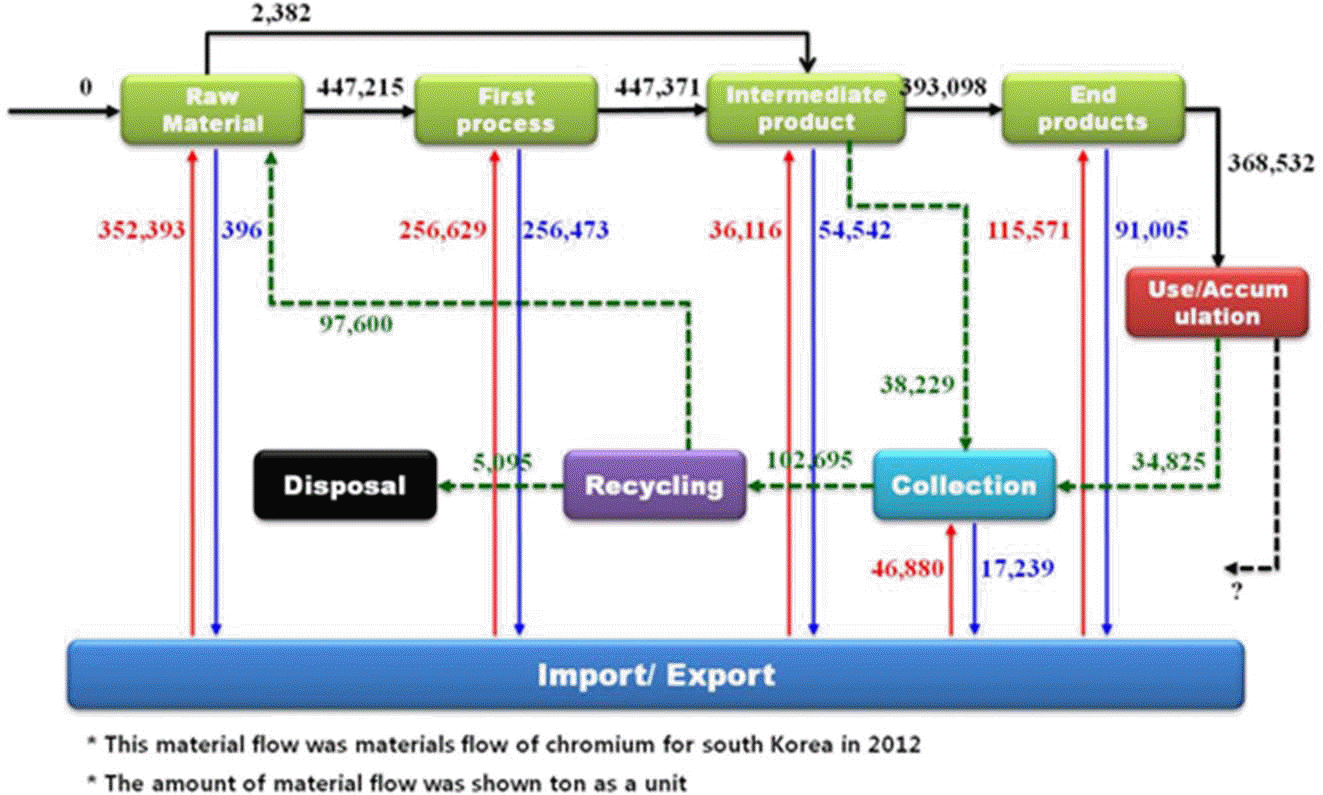Environment Emission and Material Flow Analysis of Chromium in Korea
Article information
Abstract
With the stabilization of Korea’s industrialization, it has become interested in the efficient use of rare metals, climate change and industrial environment and safety etc. It is thus making efforts to implement economic policies that address such issues. Therefore it is necessary to understand the demand, supply and use of metal materials. Since 2010, the Korean government has developed the integrated material flow methodology and has been trying to examine the demand, supply and use of metal materials. In 2013, the Korean government surveyed the material flow of chromium. Material flow analysis and environment emission of chromium were investigated 8 steps; (1) raw material, (2) first process, (3) Intermediate product, (4) End product, (5) Use/accumulation, (6) Collection, (7) Recycling, (8) Disposal. Chromium was used for stainless steel, alloy steel, coated sheets, refractory material and coating materials. Recycling was done mainly in use of stainless steel scrap. To ensure efficient use of chromium, process improvement is required to reduce the scrap in the intermediate product stage. In the process of producing of the products using chromium, it was confirmed that chromium was exposed to the environment. It requires more attention and protection against environment emission of chromium.
1. Introduction
Since 1970’s, Korea achieved rapid economic development through industrialization. However, because of the lack of natural resources, Korea has relied heavily on imported resources for its economic development. In particular, it imports almost all its required fossil fuels such as bituminous coal, heavy oil, and liquefied natural gas (LNG), as well as all the materials required by its steel industry, which is essential for its industrialization.
With the stabilization of Korea’s industrialization, Korea started to have an interest in the efficient use of natural resources, climate change, etc. And it is a lot of efforts to implement economic policies in accordance with such issues. It is making considerable efforts to reduce its CO2 emissions, and fully supporting R&D activities for renewable energy and industrial development.
Korea has also been achieved R&D and application in materials, but not enough for rare metals. Because most of its rare metals are imported, Korea has difficulty in responding to rapid price fluctuations and demand/supply imbalance. It is necessary to understand the demand, supply and use of rare metals, therefore it makes possible to efficient use and stable resource supply. Since 2010, the Korea has been trying to examine the demand and supply of rare metals by material flow analysis, and to secure their more efficient use and stable supply.
In 2013, the Korea surveyed the material flow of chromium. Chromium is buried and mined mostly in the Republic of South Africa, Kazakhstan, and India etc. Table 1 shows the worldwide reserves of chromium ore [1]. Kazakhstan, the Republic of South Africa, and India account for more than 98% of the worldwide reserves. Table 2 shows chromium ore production in world [2-5]. Chromium reserves are largest in Kazakhstan, but chromium production is highest in the Republic of South Africa. Although it has not been statistically identified, China was produces 2,600,000 tons of ferro-chrome annually, including the chrome ores were imported from the Republic of South Africa and production of chrome ores in china [6].
Such as Platinum Group Metals, Rare earth elements and chromium (Chromium) etc, ubiquitous resources are larger difference by region, and would be expected to be a problem in the supply in the near future. In particular, there is no natural resources countries as Korea, it have a large serious with respect to depletion of resources.
Korea is essential to secure basic data for their supply and demand by chromium-specific material flow analysis. And with the analysis results, Korea can recognize the efficient usage, supply and demand for chromium and the possibility of recycling.
And, chromium has been classified as hazardous substances. Therefore, it is necessary to conform that environment part is exposed to chromium. We can make to determine exposure to the environment by whether the product or the process. We can checks the management of hazardous substance chromium. Framework Act on Environmental Policy was enacted in 2002 and has been enhanced in Korea [7]. And as well as Korea, environments law has been enhanced globally. To coping with the strengthening of global law regulation and to ensure the safety of Korean people, the environment emission of Chromium was examined by Chromium’s material flow analysis.
2. Integrated Material Flow Analysis
2.1. Integrated material flow analysis methodology
The integrated material flow analysis methodology of Korea [8, 18] uses both top-down and bottom-up material flow analysis results. The material flow analysis, wherein reliable data are essential, applies the bottom-up method to the flow of primary and secondary resources, and the top-down method, to the distribution structure analysis of intermediate and end-products, for which field data or actual statistical data are deficient.
Fig. 1 shows an example of the two aforementioned methods in the integrated Material Flow Analysis methodology. The domestic demand and supply according to the domestic production and imports/exports at the level of mineral ores and metal ingots can be analyzed with the bottomup method using statistical data and field survey data; but in the case of the resource inputs in the end-products stage, it is difficult to apply the bottom-up method because the flow of all domestic industries and products must be investigated. In this case, the top-down method can be used to estimate the industry flow.
In this integrated MFA, the user can select either the top-down method or the bottom-up method for their merits and demerits to address the problems of each methodology. The integrated MFA shows not only the integrated data but also the material flows of both the primary and secondary resources.
Fig. 2 shows the concept of the integrated material flow, which was developed in Korea. This concept somewhat differs from the integrated material flow concept proposed by Katholieke Universiteit Leuven in Belgium [9].
In the integrated material flow of Korea, collection and recycling related to the urban mines are separated respectively. The scrap produced from the first process stage and the intermediate product production stage and afteruse products are collected in the collection stage. And the scrap and the after-use products proceed to the recycling stage through the collection stage. The integrated material flow and the environment emission of chromium are investigated into the following eight stages.
(1) Raw material stage (2) First process stage (3) Intermediate product stage (4) End product stage (5) Use/accumulation stage (6) Collection stage (7) Recycling stage (8) Disposal stage.
2.2. Environment emission and integrated material flow analysis of chromium in Korea
The environment emission and integrated material flow analysis of chromium were investigated on basis of the amount of chromium used in Korea in 2012. The amount of chromium was converted into the net weight. This survey was conducted based on the actual inspection data of companies and the national statistics related to the raw material stage, first process stage, intermediate product stage, collection stage, and recycling stage.
2.2.1. Raw materials stage
The raw materials stage of chromium spans chromite, ferro-chromium and the chemical processes applied to the production of chromium compound. The survey showed that no company produces chromite and its concentrate in Korea. In addition, there are no manufactures compounds of chromite and its concentrate. Moreover, no company produces ferro-chromium and chromium compound, all of which are imported. Korea imported 102 tons of chromite. The imported chromite was entirely used to produce refractory material. A total of 308,114 tons of ferro-chromium was imported, and 307 tons was exported. The imported ferro-chromium had different chromium contents by country of production, and the net weight was calculated using the relevant company data.
There was 97,600 tons of stainless steel scrap, which was inputted from the recycling stage. The amount of chromium compounds was calculated in terms of their net weight using the chromium content and the imported amount.
The imported chromium was 44,177 tons, 89 tons of which was exported. Approximately 95% of the chromium compound was supplied for the surface treatment of carbon steel, and the rest of it, for the coating. Refractories are produced by the following process; Grinding - Mulling - Forming - Drying - Firing process with the chromite. The fry dust of chromite Ore was generated and emitted to the air in the grinding process. The amount emitted into the air of Chromite ore did not know, because manufacturers and national statistics have been not investigated. When the refractory material was produced by chromite ore, generated dust was ìm to tens ìm. For the safety of workspace, the systemic administration is required with respect to the chromium containing and micrometers dusts.
2.2.2. First process stage
For the first process stage, the data were collected from a survey of the relevant company and from literature. The ferro-chromium and the chromium compound in the raw material stage were inputted into the stainless steel, alloy steel, carbon steel, and refractory material. For these applications, IMFA was conducted.
Stainless steel and alloy steel were manufactured into half-finished products such as billets, blooms, and slabs, and then produced in forms that were useful for intermediate products, including as wires, section shape steel, and sheets. In the stainless steel, 233,896 tons of chromium was that was imported as the first process product. And 230,677 tons was exported among the first process products produced stainless steel in Korea. The imported stainless steel was mostly 200 series stainless steel from China. And 300 and 400 series stainless steel were exported from Korea. It was found that relatively cheap 200 series stainless steel was imported to Korea. 389,759 tons of chromium was inputted in the stainless steel in the raw material stage.
Stainless steel was produced in the forms of wires, steel bars, section shape steel, sheets, etc. in this first process stage, and produced a small amount of scrap. In this stage, scrap was produced from the cutting and deformation processes. The produced process scrap was recycled in the circulation within the plant. This corresponds to the direct recycling in the integrated flow sheet suggested by Katholieke Universiteit Leuven [9]. The produced stainless steel scrap is directly recycled because it has the same content as the manufactured products. There was 11,881 tons of scrap from the stainless steel production process, which was approximately 3% of all, and it was recycled within the plant. For alloy steel, 11,733 tons of chromium was imported and 3,050 tons was exported. 14,700 tons of chromium was inputted in the raw material stage. Most of the produced alloy steel was used to meet the demand in Korea. There was 452 tons of scrap from the production process, and it was circulated within the plant. The alloy steel produced in Korea was used in the car and shipbuilding industries and in plant equipment manufacturing. In Korea, alloy steel production was produced in an electric furnace using iron scraps. To adjust the content, the alloy elements of the scrap are removed as slag. In the field survey of the chromium material flow, Zn was recycled from the electric furnace slag, but others elements were discarded. Securing the recycling technology for the electric furnace slag is part of sustainable resource management [9]. As for chromium in carbon steel, 41,706 tons was inputted into production of color sheets and tin sheets. The produced color and tin sheets were used for the exterior materials of structures and electric appliances, 54% of which was exported.
1,050 tons of chromium was inputted in refractory materials from the raw materials stage, and approximately 5,461 tons of it was imported, which a portion of these were exported. In Korea, refractory materials containing chromium are used to produce steel and cement rotary kilns and are mostly imported. In the first process stage, over 87% of the chromium is used to produce stainless steel, as shown in Fig. 3. And with the continuous increase in the use of stainless steel of worldwide, as shown in Fig. 4 [10] the use of chromium in industrialized Korea is also expected to increase.
The high stainless steel demand in Korea is also proven by the use of stainless steel per capita, as shown in Fig. 5 and Fig. 6 [10]. The use of stainless steel, which is highquality steel, increases with the increase in the national income; especially Korea and Taiwan, its use is higher than countries with a similar income level in 2010.
At this stage, Fume, dust, slag and mill scale were emitted into environment from stainless steel and alloy steel production processes. The electric arc furnace and furnace Basic Oxygen process furnace were used in manufacturing of Stainless steel and alloy steel. Electric arc furnace is used in alloy steel manufacturing in Korea. And the basic oxygen process furnace is used stainless steel manufacturing. Electric arc furnace is used for the special purpose stainless steel. There are process emission and fugitive emissions in Stainless steel and alloy steel manufacturing process. Process emissions and fugitive emissions were not yet investigated or reported by Korea government or related companies. Also it did not know that the installation of the facility to effectively control against the environment emission of dust and fume of containing chromium that occur in the manufacturing process. We should ensure safety against the environments emission of chromium through investigation in the air emission and in the environment emission of the chromium containing production. And the scrap containing chromium from the process scrap is inputted in the refining process and chromium is removed. And recovered chromium in the refining process is used as a material for construction and cement manufacturing.
The mist containing chromium is generated in the anodizing process of the process of manufacturing color sheet and tin sheet with the carbon steel and emitted into the air. The anodizing process makes color sheet appearance easy to color and tin sheet to provide corrosion protection [11]. In the anodizing process, hexavalent chromium emission is generated by 0.6 g/hr-m2, mist containing hexavalent chromium is emitted into the air. In color sheet, 2,112kt and in tin sheet, 653kt were produced by anodizing process in Korea [12]. However there was no emission of hexavalent chromium because the device was equipped with emission control device.
2.2.3. Intermediate-product stage
The intermediate-product stage refers to the stage wherein the intermediate products are produced from the raw material stage and the first process stage for use to produce the end-products. The material flow analysis of chromium could not be limited in the bottom-up method for the first process stage to the intermediate-product stage because stainless steel and alloy steel, for which chromium were used in a wide range of products and in large amounts. The range of chromium used for adornments related to coating was also wide, and the bottomup method was not applicable. To apply the top-down method as a means of supplementation, the input coefficients in the inter-industry relations tables provided by the Bank of Korea [13] were used. The items were classified that the intermediate products and the end-products would not overlap. The intermediate products are used for other primary steel products, structural metal products, metal tanks and containers for installation, attachable metal products, metal products for buildings, metal wrapping containers, ship repair parts, and screw products. Their other applications include valves, car parts, electronic coils, internal combustion engines, turbines, molds and castings, and electronic appliances in industries and households. Their application range can be further widened if color sheets and coating products are included. The range of intermediate products covered 95% of the chromium that is inputted in the intermediateproduct stage. The scrap was produced from the intermediate- product production process, which is required for the end-products. According to the survey on stainless steel processing manufacturers, the amount of produced scrap was confirmed to product about 5-10%, depending on the process. This was similar in the case of alloy steel. The following Table 3 shows the inputs, imports, exports, and supply of the intermediate products The imports and exports of the other primary steel products were not identified in the top-down method that used distribution coefficients. However, the inputs in the end-product stage were highest. The intermediate products with a large amount of chromium in Korea are in car, general machine parts, chemical, and construction industries because of the developed heavy chemicals industry. The amount of scrap was approximately 10% of the amount inputted in the end-products. In Korea, a large amount of scrap was produced in the intermediateproduct stage. Process improvement and efficient material use plans are required to reduce the scrap from the intermediate-product production stage. The by-products of the intermediate-product production process are useful for recycling because they are not mixed with other impurities. Chrome emission was occurred in the coating process with chromium compounds. Chromium emission is released into the environment in the water cleaning, chromic acid of chromium treatment and electroplating of chromium in coating process.
Korea has various regulation laws with respect to emissions of chromium and hexavalent chromium. The amount of chromium in the Water quality standards was limited to 0.005 mg/L in the framework act on environmental policy [14]. Standard of containing toxic substances such as dust standard of designated waste, Waste Foundry Sand, mortality, waste refractory, ceramics drift, incineration residues, stabilization or solidification process materials, waste catalyst, adsorbent waste, sludge etc is 1.5 mg/L for hexavalent chromium compound in Radioactive waste control act [14]. Air pollutants are limited below 1.0 mg/S·m2 the amount of chromium compound for chromium and chromium compounds in clean air conservation act [15]. Hexavalent chromium is permitted only maximum 30 mg/kg in accordance with region in soil environment conservation act [16].
The companies related plating have not a waste water treatment facility independently. The plating complexes were formed by the companies related plating. And the plating complexes operate waste water treatment facilities. The waste water is collected in the waste water treatment facilities are an average chromium containing 400 ppm. But there are many companies scattered throughout Korea. However, it was confirmed that plating waste water was well managed by a professional management companies. The plating waste water was purified through the recovery process of chromium. And recovered chromium was buried. Mist generated in chromium process was examined to be released into the air without being managed. It requires a thorough control of the mist of containing chromium that occurs in plating process. The content of chromium and amount of the mist of containing chromium was not investigated in Korea. But the amount of hexavalent chromium in mist for the hard chromium plating is known as the average 9.8 mg/A-hr, and 1.6 mg/A-hr for decorative chromium, depending on the intensity of the current which is used for plating in the United States [17].
2.2.4. End-product stage
The end-product stage is defined by the amount supplied from the intermediate-product stage to the endproduct stage, and the production of end-products from exports and imports. The intermediate-stage products were used for the end-products such as in the construction, machinery, transportation equipment, manufacturing, metal, and electric and electronic equipment industries. Table 4 shows the imports, exports and inputs of the chromium inputted from the intermediate products. Chromium consumption was approximately 59% in the machinery industry, including for the production of machinery, transportation equipment, other manufacturing products, and precision instruments; 27% in the construction industry; and 7% in the electric and electronic equipment industry.
The amount used and accumulated in Korea reached about 368,500 tons. Chromium was used in the construction field such as for home maintenance, non-residential construction, and mechanical assembly and installation; transportation equipment such as trailers, passenger cars, airplanes, special vehicles, and railway cars; machinery such as for food, heating, and cooking; other products such as metal furniture and exercise and game products; metal products such as domestic metal products and other metal products and tools; precision equipment such as measuring and analyzing devices, automatic control instruments, and medical devices; and electric and electronic equipment such as generators, home heaters, and wireless communication devices. Thus, chromium was used for various applications. Because chromium was widely distributed in the end-products, the amount of chromium in each end-product was small, even though it varied according to the application. Therefore, a large amount of chromium was passed on from the use and accumulation stage to the collection stage, but its separation was difficult and it was handled as scrap.
When the chromium was contained in the end-products related to coating, the range of its distribution was also very wide. Coating is mostly conducted on plastic materials, for which its end-product application range is also wide. However, the chromium content was very small, and so was not collected in the collection stage. Most of the material was removed in the plastic recycling process. It seems that a significant amount was discarded in the process
2.2.5. Use/Accumulation stage
In the use/accumulation stage, the amount of end-products used in industries and house is examined.
Chromium accumulation was zero because its material flow was first surveyed in 2013. A large amount of chromium is used in a wide range of applications. Approximately 368,500 tons of chromium was used in the endproduct stage. The range of its applications included gen- eral industries such as construction, machinery, transportation equipment, and manufacturing of products such as metal furniture, wood furniture, and exercise and game products. Chromium is used in both daily life and industry, including for domestic metal products and tools, generators, heaters, wireless communication systems, measuring and analyzing devices, medical devices, and watches.
2.2.6. Collection stage
In the collection stage, the after use and the damaged product are collected by the collector. The collection of stainless steel is divided into the collection of intermediate product scraps, which are produced from the production of intermediate products, and into the collection of scraps produced from the products. The intermediate product scraps are well collected by the collector because their types and contents are consistent and easy to classify, but the after-use products in the use/accumulation stage are difficult to classify, so such scraps are collected without classification. The stainless steel that was collected from the use/accumulation stage has diverse types, and was processed in shreds and supplied as such. This was also the case with the scraps in the intermediateproduct stage. However, when carbon steel and alloy steel were collected as scraps, the values of the contained alloy elements were not considered, and the scraps were handled merely as iron scraps. However, in the case of stainless steel, the chromium and specific elements in it were considered and purchased at a high price.
In this study, the aforementioned characteristics were applied to the collection, recycling, and disposal stages. There are 35 collectors in Korea, including Dongjin Resources, Gwangdeok Steel, Seonji, Jawon, Daesin Steel, and Iksan Iron Scrap, which belong to the Korea steel scrap industry Association. In the intermediate stage, there were approximately 33,403 tons of stainless steel scraps and 4,826 tons of carbon and alloy steel scraps, for a total of 38,299 tons. 34,467 tons of stainless steel scraps were collected from the end-products, and 358 tons of refractory materials were collected. Korea imports stainless steel scraps and exports a large amount of generated stainless steel scrap in Korea, according to their international price.
Decorative chromium coated plastic is not the duty collection target of EPR(Extended Producer Responsibility) in Korea. The decorative chromium coated parts are used in automobile and the faucet. Almost cars are collected and all materials of cars are recycled. But the chromiumcoated parts are not separated from the other plastics. It is thought that chromium removed from the chromium coated plastics is released to the environment in the plastics recycling process. And faucet parts are divided into metals and plastic parts. For metals parts, Chromium is removed as impurities in the recycling process and filled with slag. But for the plastics parts, removed chromium from the recycling process is expected to be released into the environment. Administration of the process of recycling of decorative coated product is needed for the environment emission and the disposal.
2.2.7. Recycling
In the recycling stage, scraps produced from the products, process scraps, and imported scraps that have been collected from the collection stage are recycled. The collected amounts were 67,870 tons from the stainless steel, 358 tons from the refractory material, and 4,826 tons from the alloy steel and carbon steel. Among the collected scraps, all the stainless steel scraps were recycled. The chromium in the alloy steel and carbon steel was inputted in the electric furnace and removed as slag, along with other alloy elements, as impurities. When alloy steel manufacturers purchase iron scrap, they consider it pure Fe scrap because the types and amounts of the alloy elements are unknown. Part of the impurities that were removed from the electric furnace process was recycled, but chromium was not included. As for the after-use refractory material, approximately 70% of it was used and 30% was collected. All the used refractory materials collected were discarded. It is required the countermeasures for the used refractory materials.
2.2.8. Disposal
In the disposal stage, chromium is finally discarded, that is, in the use/accumulation stage, end-product stage, and recycling stage. Chromium is not recycled except when it is contained in stainless steel. In the case of the refractory material, chromium was not recycled because of its toxicity. Accordingly, it is replaced by an oxide such as MgO. In the case of chromium in alloy steel and carbon steel, it was used in various applications, and its contents vary. Therefore, it was removed with impurities and discarded.
Of the slag generated from electric furnace process in alloy steel manufactory, Zn was recycled in Korea, but the other elements were not recycled but discarded as slag. Chromium in the form of the coating on plastic materials and mechanical parts was also not recycled but discarded because its concentration is low. As for chromium (III) for coating, it is not suitable for wide use in industry because its coating characteristic is below that of chromium (VI) and it is related to patent rights. However, since EU limits the use of chromium (VI), countermeasures for addressing the aforementioned issue are essential for the export-oriented Korean industries. As for now, there are many limits in the use of chromium (III), and significant research and development efforts must be made to countermeasure such issue.
Fig. 7 shows the chromium material flow in Korea. In 2012, approximately 447,200 tons of chromium was inputted in the first process stage. Approximately 87% of it was used to produce stainless steel, and 5.2% was used to produce alloy steel and 5.5%, carbon steel. Approximately 97% of the total amount of chromium was used in the steel industry, and the remaining 3% was used for coating and refractory materials.
3. Conclusions
The following conclusions were made about the material flow analysis and the environment emission of chromium, which is used for stainless steel, alloy steel, coated sheets, refractory and coating materials in Korea.
In the raw materials stage, the micrometer size dust was released into the air in the grinding process etc. by the use of a chromium Ore in refractory production process. Safety management and dust countermeasures are required in the workplace.
In the first process stage, the investigation of environment emission was conducted against the relevant company. But the amount of environment emission is not possible to determine. The occurred scrap in the workplace had been well managed. And the scrap generated in the manufacturing process of stainless steel and alloy steel was recycled.
In the intermediate product production, the chromium inputs were 447,371 tons in the first process stage and 2,382 tons in the raw material stage, and the imports and exports were 36,116 tons and 54,542 tons, respectively. In the intermediate product production stage, 38,229 tons of scrap was produced and inputted in the collection stage. The cleaning water was treated with a purification process that occurs in the decorative coating and chromium hard coating. And the recovered chromium was buried. But countermeasure of the generated mist in the chromium coating process is required.
In the first process stage, 12,343 tons of process scrap was produced, but it was recycled all within the plant. In the intermediate product production stage, 38,229 tons of process scrap was produced and inputted in the collection stage. The amount of scrap produced in the intermediate product stage was approximately 8.5% of the amount of chromium inputted in that stage. The amount of scrap produced must be reduced through the process improvement and control. When the collected decorative coating plastic is recycled, the removal process of chromium is required.
As for the characteristics of the chromium material flow in Korea, most of the raw material was imported, and the imported amount was almost equal to the exported amount in the first process stage. However, in the intermediate product stage, the export was approximately 51% higher than the import, but was only approximately 18,400 tons, which was not so large. Considering that Korea is export-oriented, industries related to chromium is run to meet the demand inside Korea. Therefore, Korea, which has been developing based on heavy chemical industries, needs stable chromium supply to ensure its continued development.
Of the chromium that is inputted in the recycling stage in Korea, 67,870 tons is in the form of stainless steel; 4,826 tons, alloy steel and carbon steel; and 358 tons, refractory material, for a total of 73,054 tons. The scrap was exported and imported in the form of stainless steel, 46,880 tons was imported and 17,239 tons, exported.
97,600 tons of chromium in the form of stainless steel was inputted in the actual raw material stage and recycled. All the chromium in the alloy steel, carbon steel, and refractory material was discarded.
As dust contained chromium was generated in the manufacturing process, and exposed in the air, the form of a mist, in coating process and the form of fume in stainless steel and alloy steel process. The water containing chromium has been generated in the cleaning process of decorative and hard coating. The collected chromium of decorative coating plastics was buried.


